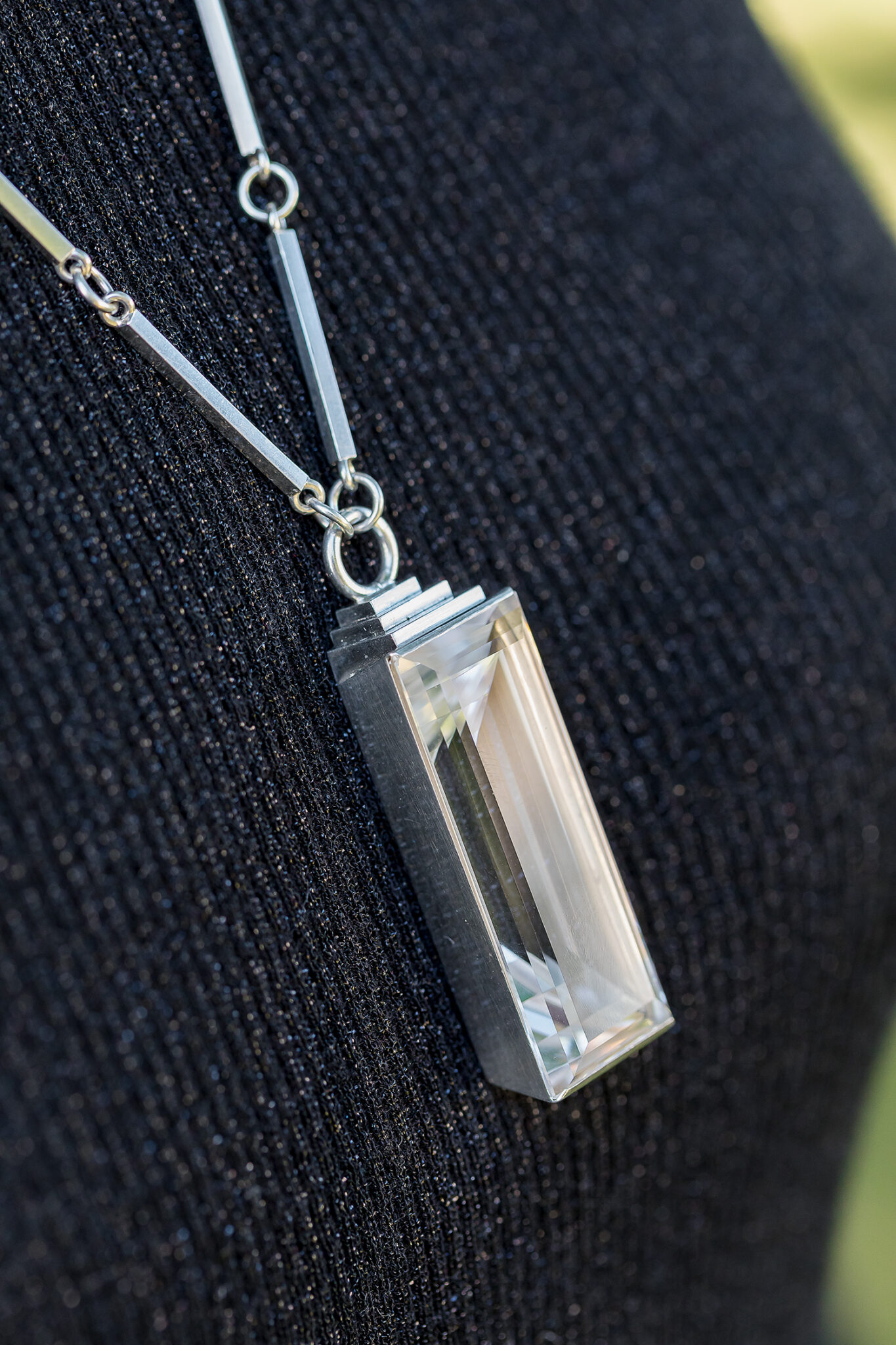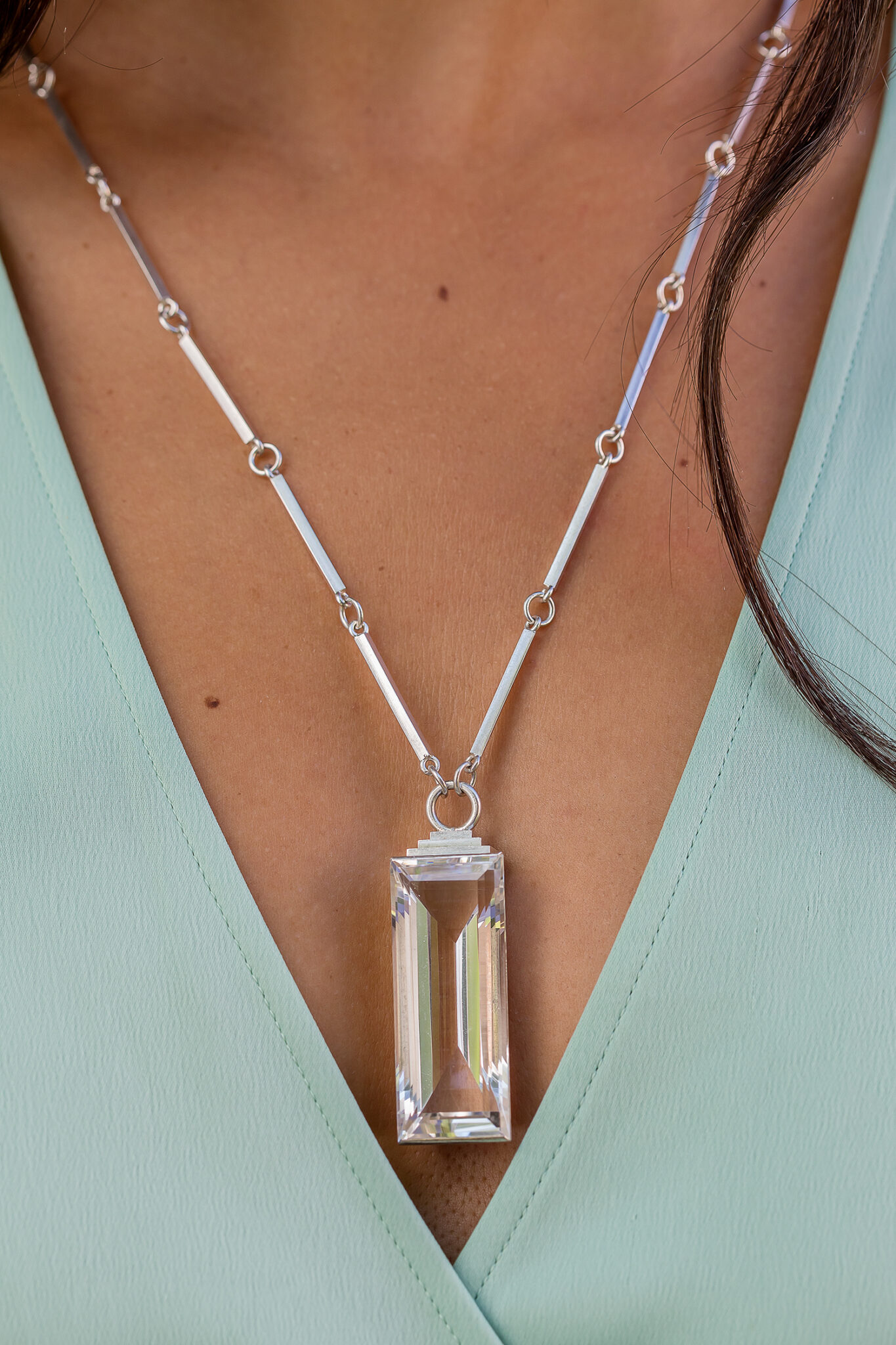Silver and approx 85ct rock crystal. Signed and dated 1937. The pendant is 6,7 cm long on a
59 cm long chain. Replacement lock.
Wiwen Nilsson (1897-1974) – An Art Deco Silversmith in the Age of Modernism.
Wiwen Nilsson was born in Copenhagen, Denmark in 1897. Born as Karl Edvin, but since he did not like his christening name, he was, within the family, called Wiwen. He was the son of Karolina and Anders and grew up with his sister Edith. In 1897 the family moves to Lund, Sweden when the father takes over the gold and silversmith company J.P. Hasselgren & Son.
In 1906, Wiwen began at Katedralsskolan in Lund and finished school when he graduated fifth grade in 1912. It was common to continue up to sixth grade and then high school, but Wiwen who does not thrive in a school environment wants to become a pianist or aviator instead. However, as the father is a recognized jeweler and court supplier, the son’s career is already marked. Instead, he embarks on an educational journey with the goal Königliche Zeichenakademie in Hanau am Main, Germany. The school is Germany’s oldest and most prestigious goldsmith’s school. Wiwen enrolled on the fourth of August in 1913 and studied drawing, workshop work, engraving and hammering work. The education comes to an abrupt end with the outbreak of the First World War in 1914, and he instead continues his education in his father’s workshop, where he stays until 1919. He does, however, make two breaks, the first quarter of 1917 he enrolled at the Technical Society’s School in Copenhagen where he studied modeling, among other things, and in 1917-1918 he did his military service in Stockholm. In 1919 he applied for and received his companion letter, at the same time he received the Swedish Craft Organization’s large medal in silver for his professionalism.
In 1920 he is again at the school in Hanau, Germany where he stays until 1921 and practices with the jewelry company Chr. Kissling also in Hanau. At school, he mainly studies drawing and chiseling, a type of relief technique that was very popular during the 17th century. Wiwen is driven by his own design language and thinks that the prevailing technique under the influence of Danish designers is a setback in the development of chiseling. During his time in Hanau, he visits several arts and craft exhibitions and comes into contact with the Wiener Werkstätte and the Wiener Werkbund, among others. At the same time as he is studying, he writes travel stories where it emerges that he believes that Sweden’s conservatism inhibits the development of arts and crafts, something he himself wants to change.
Back in Sweden in 1921, he was appointed the company’s artistic designer. In 1923, the company participates in the Gothenburg exhibition, but here Wiwen receives devastating criticism. His creations are considered ugly and meaningless, a critic writes that it is a typical case of poor material sense.
In 1924, Wiwen Nilsson travels to Paris. Just like in Hanau, he studies chiseling, silver, drawing and modeling at the Académie de la Grande Chaumiére (now Académie Charpentier). One of France’s foremost art schools where, among others, Siri Derkert (1888-1973) and Bror Hjorth (1894-1968) have also studied. In Paris he became acquainted with Georg Jensen (1866-1935), in whose workshop he chiseled for a period. He also meets and hangs out frequently with Jules Schyl (1893-1977) and Gösta Adrian-Nilsson, GAN (1884-1965). The meeting with GAN becomes extremely important and came to influence and refine Wiwen’s own design language and together they hold a joint exhibition in 1925 in Lund.
From 1925 until the end of the 1920s, Wiwen Nilsson produces a large amount of church silver. He designs and manufactures for, among others, Allhelgonakyrkan in Lund, Knästorps and Tottarps kyrka in Skåne. In total, Wiwen’s workshop manufactures 677 objects for churches, of which 483 are found in churches within the diocese of Lund and 194 in other Swedish churches. Some are also sent internationally to the Church of Sweden in Paris, Berlin, Copenhagen and churches in West Germany, Iceland and to Zululand in South Africa. His church silver unmistakably bears the same design language as his profane works. All with the same angular but harmonized and modernist shapes, not infrequently his vessels like jugs and lid boxes are often hexagonal or octagonal.
In 1925 he participated in the Exposition Internationale des Arts Décoratifs et Industriels à Paris (World Exhibition) where he received a gold medal in Class 10, the category for crafts and art industry in metal. Other exhibitors included C.G. Hallbergs Guldsmeds AB and Jacob Ängman in Stockholm. With the successes after the exhibition, Wiwen and his company were invited to exhibit at two exhibitions, in Gothenburg and Zurich in 1926 and in the Swedish Handicraft Association’s exhibition at the Metropolitan Museum in New York in 1927. The same year (1927) Wiwen takes over his father’s business in Lund for that the year after 1928 be appointed court jeweler and open branch in Malmö. After he took over the company, Wiwen’s influence is clearly visible in the company’s production, his design language flourishes and is included in many of the new products that are marketed. The company is now also starting to produce a large number of prizes, primarily athletic prizes in the form of trophies of various kinds. The Lund Cup from 1929 can be mentioned here, which was shown at the Stockholm Exhibition in 1930.
At the exhibition, Wiwen receives mainly positive reviews and the opportunity can be seen as a great success for himself and the company, this will be his breakthrough in Stockholm. The National Museum in Stockholm decides, among other things, to buy two of his exhibited objects, an octagonal vase and a hexagonal tea box with an ebony knob. His most modernist and technically most advanced object at the exhibition is a hexagonal wine jug, also this one with a knob and grip in ebony. At the same exhibition, he also shows a large number of jewelry. These are mainly characterized by their geometric shapes and the use of rock crystal. His jewelry had an international impact at the World’s Fair in New York in 1939. The success led, among other things, to the director of The Swedish Arts and Crafts Company Tage Palm (1892-1959) opening a store on 57th Street in New York selling exclusive sculptures of Carl Milles, glass by Orrefors, and Wiwens jewelry.
During the 1950s and 60s, Wiwen Nilsson continued to create and maintain frequent contact with GAN. At the H55 exhibition in Helsingborg in 1955, GAN participates with, among other things, a tapestry in interaction with one of Wiven’s sculptures. During the same decade, Wiven was alone in Sweden in letting East Asian art influence his jewelry work. Worth mentioning are a number of brooches designed as cranes.
Wiwen died after a period of illness on January 8, 1974 – 77 years old.





































